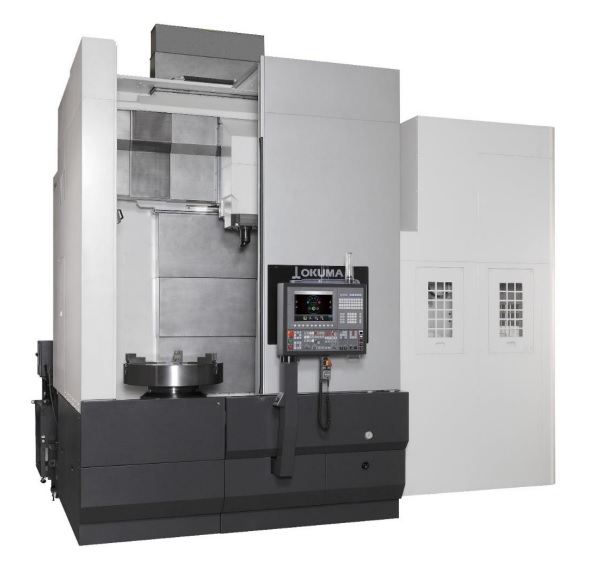
Okuma Corporation has developed the vertical CNC lathe VT1000EX that achieves extraordinary productivity of machining difficult-to-cut materials. This unit has the highest machining capability in its class due to its highly rigid mechanical configuration so that the cycle time for difficult-to-cut materials is reduced drastically. In addition, the reduction in cycle time means that CO2 emissions are reduced. The VT1000EX will provide a new level of productivity to a wide range of markets that have to deal with difficult-to-cut materials. These markets include the energy sector, especially wind power generation which is in the focus of attention with the accelerated movement towards decarbonization, and the aerospace sector which is starting to recover.
Background
Titanium, Inconel, stainless steel, and other difficult-to-cut materials are of high strength and have superior heat and corrosion resistance. As a result, there is an increasing need for these materials in a wide and varied range of markets, including the energy sector centering on wind power generation, the aerospace sector, and the construction machinery sector. However, it has been difficult to increase machining areas and speeds for machining difficult-to-cut materials so that improving productivity has been an issue.
The transition to a decarbonized society in recent years has made it imperative for the entire manufacturing industry to consider production systems that account for the environment. This requires them to reduce CO2 emissions in the production processes.
Under these circumstances, there is a need for machines that can drastically improve the productivity
of machining difficult-to-cut materials with extraordinary machining capability, that can reduce CO2
emissions in production processes, and that can maintain stable operation over long periods.
Development Goals
The new VT1000EX has been developed under the following concepts to solve the issues directly facing users, such as improving the productivity of machining difficult-to-cut materials and promoting their efforts towards a decarbonized society.
(1) Extraordinary cutting capability that can drastically improve the productivity of machining difficult-to-cut materials.
(2) Reduce CO2 emissions in production processes by drastically reducing cycle times.
(3) High reliability provides machines that do not break down and can maintain stable operation for long periods.
Features and Technology Developed
(1) Extraordinary cutting capability that drastically improves the productivity of machining difficult-to-cut materials
- Cycle time is drastically reduced by ultra-heavy-duty cutting with the greatest machining capability in its class.
Cutting capability of difficult-to-cut materials (Inconel 718): 6.7 mm2 (actual value) (2 times that of conventional machines)
Cycle time: 13 min 40 sec → 6 min 42 sec (actual value) (51% reduction compared with conventional machines)
(When machining a sample workpiece of Inconel 718 at our company)
- A highly-rigid machine configuration that makes ultra-heavy-duty cutting of difficult-to-cut materials possible.
A new standard spindle with high output and high torque
Maximum output: 55 kW (1.8 times that of conventional machines)
Maximum torque: 5,310 N·m (2 times that of conventional machines)
Bearing inner diameter: Φ260 mm (1.3 times that of conventional machines)
A wide guide span that provides strong support during ultra-heavy-duty cutting.
X-axis: 1.4 times that of conventional machines
Z-axis: 1.2 times that of conventional machines
We have achieved a larger guide span on a floor area equivalent to that of conventional machines.
- Continuous long-period operation even for machining difficult-to-cut materials is achieved with a standard ATC.
A standard 36-tool magazine allows continuous long-period operation even for machining difficult-to-cut materials that require frequent tool changes.
The tool exchange time is reduced by 30 percent compared with conventional machines so that productivity is improved even more.
(2) CO2 emissions from the production process are reduced by drastically reducing the cycle time
- Reducing the cycle time (51 percent reduction compared with conventional machines) reduces the power consumption per cycle of roughing.
Power consumption: 4.5 kWh → 3.1 kWh (32% reduction compared with conventional machines)
- ATC tool-exchange time reduction (30 percent reduction compared with conventional machines) reduces the annual power consumption.
Power consumption: 95 Wh → 68 Wh (28% reduction compared with conventional machines)
- Annual CO2 emissions reduction due to shorter cycle times
15t-CO2/machine → 10t-CO2/machine (32% reduction compared with conventional machines)
(3) High reliability provides machines that do not break down and can maintain stable operation for long periods.
- An optimized machine construction that prevents the accumulation of chips. An enlarged chip discharge port (1.5 times that of conventional machines) and stainless steel chute have been adopted.
- Machine-interior chip flusher that facilitates smooth discharge of large chips that are produced by ultra-heavy-duty cutting. Downtime is reduced the machine is not stopped for cleaning.
This makes long-period stable operation possible even for ultra-heavy-duty cutting that produces large chips.














